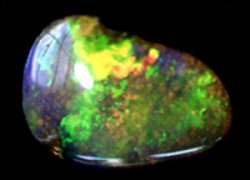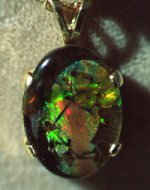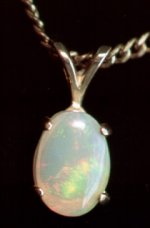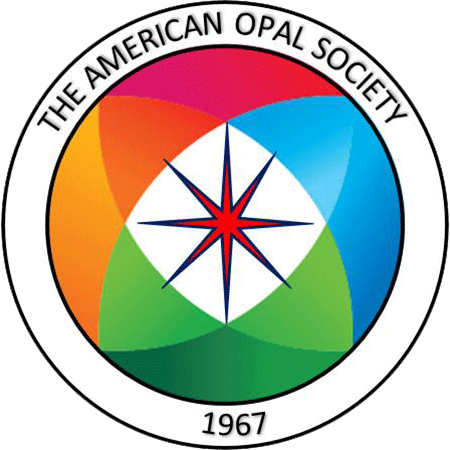Opal Express Newsletter
The Opal Express Newsletter is published monthly by the American Opal Society and distributed to current members. It contains articles on opals, opal mining, opal cutting, opal jewelry, club meeting notices, member information, and other relevant information. For a complete list of issues by year/month, visit the the members-only Opal Express Archives
A Table of Contents of older newsletters by topic is also available.
The American Opal Society offers limited opal-related advertising, at a nominal fee, in the Opal Express.
For more information on receiving the Opal Express or advertising in it, please contact us at info _at_ opalsociety _dot_ org
Address Label: Your address label on the Opal Express Newsletter that you will receive after you join indicates your dues expiration date as "ME"MM-DD-YY, where MM is the month, DD is the day, and YY is the year your dues expire.
Below is an article from the March, 2002 issue. Other back issue articles may be found in the members-only Opal Express Archives.
Precious Opals in Canada
By Bob Yorke-Hardy
Okanagan Opal Inc., Vernon B.C.
Member, American Opal Society
October is Opal month and it has been interesting to read about various opal deposits from around the world in the October issues of the popular American published Lapidary Magazines. These articles have discussed various opal sources; however, there was no reference to an opal source in Canada. It would seem that there is little awareness of the Klinker Opal Deposit - Canada's first precious opal discovery being contemplated for commercial production - located near Vernon, B.C. Perhaps in this short dissertation we can start to fill this information gap.
Discovery and Commercial Development
The Klinker Opal Deposit was discovered on October 14, 1991, our Thanksgiving Day, and has been technically reviewed in two articles co-authored by the Geological Survey of Canada and the B.C. Geological Survey. Also, there have been several articles in past issues of both Lapidary Journal and Rock and Gem about this deposit.
Since its discovery in 1991 extensive progress has been made towards commercial development of the property. Likewise, during the past three years there has been considerable activity and some success by others looking for additional precious opal deposits - yes! There is precious opal in British Columbia, Canada!

Natural boulder black opal.
With determined effort beginning in 1994, Okanagan Opal Inc. has explored and developed the Klinker Property to the stage where adequate reserves of opal have been identified to support small scale mine production provided that an adequate market can be developed. Since 1995, the company has been researched and developed various techniques for product manufacture. Market testing to assess consumer acceptance has been ongoing through its in-house retail outlet located near Vernon, B.C. The company is now preparing to expand its market base through a wholesale marketing distribution plan, the implementation of which, is the final remaining hurdle to commercial production.
An introductory opal product line of a variety of gold and silver jewellery settings has been developed by the company in order to test the marketability of "Okanagan Opal" in its various forms. This effort is increasingly meeting with both success and amazement:
- Success in that, annual sales have been increasing through our retail outlet in Vernon, B.C. and success also in that, product quality and variety has been improving steadily. In addition, sales are developing at other shops displaying Okanagan Opal products.
- Amazement in that, as we introduce our product on a wholesale basis for sale through other retail outlets it is repeatedly viewed with surprise as to the colour brilliance, the variety in opal types and base colour variations. It is truly a unique Canadian product.
The most common statement made by consumers and wholesale buyers alike is: "This opal doesn't look like the Australian opal that I am familiar with!" Our typical response is: "No, you are right!"
Then we proceed to show these potential customers solid white to honey base colored opal from the Klinker deposit that is very comparable or better than the average white opal found in many jewellery stores. We go on to explain that there are other "types of opal" which are not often seen in the average jewellery store - these other types of opal are generally more expensive.
Characteristics
Opal from the Klinker Deposit (and opal that we have seen from other more recently discovered opal occurrences in B.C.) would be generally classified as "boulder opal". This material exhibits variable base colours ranging from transparent, water clear to clear amber to translucent/opaque white to dark brown and exhibiting a variable intensity "play of colour" in a flash to broad flash pattern. The brightness and pattern of the play of colour in Okanagan Opal is second to none; often covering the full spectrum and covering the full brightness scale.

Capped boulder opal doublet pendant.
Yes, there is "solid" opaque to translucent, white base colored opal on the Klinker property; similar in appearance to Australian white opal. The Okanagan Opal found on the Klinker Property has a variable play and intensity "play of colour" and it generally exhibits "flash to broad flash fire patterns" rather than the more typical pinfire pattern found in much of the Australian white opal. In fact, on the Klinker Property there is solid opaque, solid semi-crystal and solid crystal opal; all with broad ranging base colours and broad ranging pattern and intensity of colour play. However, the economic potential of the Klinker deposit is at this stage reliant on the development of the "boulder opal" segment of the market because to date the volume of "solid" opal is not sufficient to justify commercial production on its own.

Natural solid semi-crystal opal pendant.
Perhaps this should be considered a blessing, because when comparing different types of opal, boulder opal is generally more highly valued than opaque white base colored opal. Although the Australians are still producing considerable quantities of white base colored opal it would appear that they are no longer producing the historic quantities of high quality solid black and crystal opal because it is becoming more rare. As an alternative, the Australians appear to be increasingly involved in marketing boulder opal to take up the slack. This should result in the increased awareness and value of boulder opal in the marketplace which as a consequence will result in increased acceptance of precious opal from British Columbia.
Okanagan Opals are cut into 5 types of Gemstones
The manufacturing and cutting techniques used and the product produced by Okanagan Opal Inc. are similar to those found in the "opal industry" worldwide.
- Solid Opal gemstones are cut from the larger more competent pieces of precious opal. Smaller pieces and chips of opal are used in inlay jewellery.
- Boulder Opal gemstones are cut from the more competent pieces of opal bearing rock utilizing the natural rock as part of the body of the stone.
- Black Backed Doublets which are composite gemstones created by backing crystal opal (transparent to translucent precious opal) with black serpentine or other dark colored rock.
- Boulder Opal Doublets which are composite gemstones created by adhering quartz caps onto layers of opal which are still attached to the natural host rock. Boulder opal doublets are created using the same techniques as are used to make Ammolite doublets.
- Opal Triplets gemstones and opal chip inlay jewellery are also made.
Base Colours of Opal found on the Klinker Property
Transparent to opaque common and precious opal in a broad range of base colours is found on the property. The transparent precious opal and non-precious opal ranges from water clear to light to yellow to amber to orange similar to Mexican "fire opal". Translucent and opaque types of opal range from white to honey to dark brown, grey-black, blue and salmon-pink in colour.
In 1997 the first "Boulder Black" and "Boulder Brown" opal was produced from the Klinker Property. To date precious opal (opal with a play of colour) has been found in all of the various base colours except the grey-black types. To date no "precious black opal" has been found on the Klinker Property.
For more information about "Okanagan Opal" and the Klinker Opal Property, visit our website at www.opalscanada.com. While you are there, check out the "Fee Digging" section and look over our developing line of opal jewellery.
Copyright ©1998-99 Bob Yorke-Hardy
E-mail: okopal _at_junction _dot_net
Permission is given to freely reprint this article from the Canadian Rockhound for non-commercial and educational purposes, provided the author and the Canadian Rockhound are acknowledged, and that the website URL address of the Canadian Rockhound is given. The article may not be edited or rewritten to change its meaning or substance without the author's permission. To contact the author, please use the e-mail address provided.
From the Canadian Rockhound Winter/Spring 1999 Volume 3, Number 1
www.canadianrockhound.com
